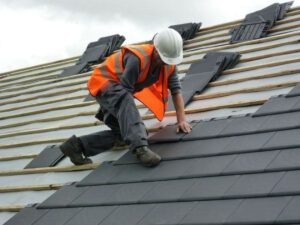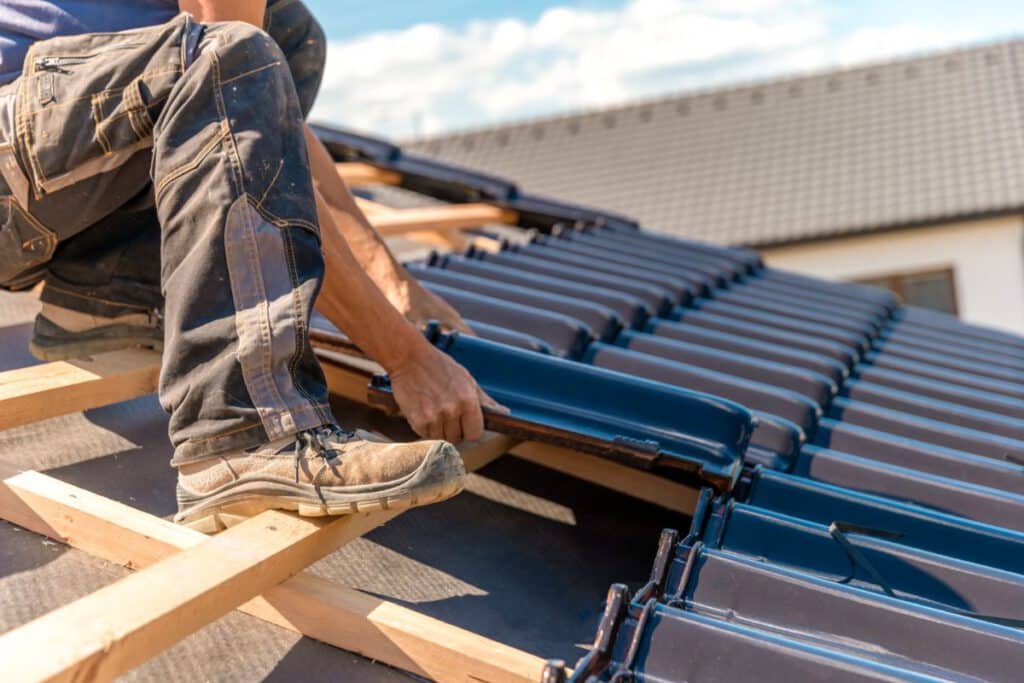A leaky roof is not just a minor inconvenience—it’s a symptom of potential underlying damage threatening the safety and comfort of your home. Ignoring a leak can lead to severe consequences, including structural deterioration, mold growth, and damaged insulation, compromising your living space’s air quality and thermal efficiency. This guide is designed to arm homeowners with comprehensive knowledge on how to fix a leaky roof, emphasizing the urgency of addressing such issues promptly.
The impact of a leaky roof extends beyond just physical damage. It can significantly affect the resale value of your home, with potential buyers likely deterred by the signs of neglect or underlying issues. Moreover, the cost of remedying the resulting damage can escalate quickly if leaks are not addressed promptly. Recognizing the signs of a leak, understanding how to locate its source, and knowing when to call in professional help are essential skills for any homeowner.
This guide will walk you through every step of the process, from roof leak detection to temporary roof leak fix techniques, selecting the right roofing contractor, and implementing long-term solutions that ensure your roof’s integrity. Whether you’re dealing with a sudden leak following a storm or you’ve noticed signs of a slow leak over time, this ultimate guide has you covered.
Identifying the Source of the Leak
Identifying the source of a roof leak can be akin to detective work—requiring patience, precision, and a systematic approach. Water often travels far from the original entry point, making the source elusive. Here’s a more detailed look at strategies for roof leak detection to accurately find and address the problem:
Visual Inspection
To ensure a safe and secure living space, it’s important to conduct a comprehensive inspection of both the interior and exterior of your home. Internally, inspect your attic during or immediately after rain for fresh water trails or spots. Look for signs of mold, moisture on insulation, or rusted nails indicating moisture presence. Externally, inspect the roof for missing, damaged, or aged shingles, damaged or missing flashing, and compromised sealant around roof penetrations like vents and chimneys.
Water Test Method
If the leak isn’t obvious, enlist help for a controlled water test. Use a garden hose to simulate rain over suspected areas while someone watches inside for drips. This method requires methodical application, starting from the bottom of the suspected area and slowly moving upward, allowing time for water to seep through potential entry points.
Common Leak Sources
- Chimneys: Examine the flashing and the state of the mortar and bricks. Water can enter through any cracks or gaps.
- Roof Valleys: Check for signs of wear, improper sealing, or debris accumulation that could block water flow and cause pooling.
- Flashings: Inspect flashings around roof features for tears, bends, or detachment. These are critical areas prone to leaks due to their role in sealing the roof’s discontinuities.
- Shingle Damage: Look for cracked, buckling, or missing shingles, as these are direct paths for water ingress.
By meticulously following these steps, you can accurately identify the leak’s source, setting the stage for effective repairs.
Temporary Fixes While You Wait for Professional Help
While waiting for professional repairs, taking immediate action to mitigate water damage is crucial. Here are expanded tips on implementing a temporary roof leak fix:
Using Tarps
Covering the affected area with a waterproof tarp can provide immediate protection against further water ingress. Secure the tarp with wood strips nailed to the roof, ensuring it’s stretched tight to prevent water pooling. The tarp should cover the leaking area completely, extending over the roof’s peak to ensure water runs off and doesn’t seep underneath.
Roofing Cement
Roofing cement can quickly fix minor leaks, especially around roof penetrations or damaged shingles. Clean the area thoroughly before applying the cement to ensure it adheres properly. Spread the cement over and around the leak using a putty knife, pressing it into any cracks or gaps.
Epoxy or Sealant for Metal Roofs
Specific products like epoxy or metal roof sealant can temporarily seal leaks if you have a metal roof. These materials are designed to adhere to metal surfaces and can provide a waterproof barrier over small holes or seams.
Patching Material for Flat Roofs
Flat roofs may require a different approach. Use a patching material compatible with your roof’s material to cover holes or tears. Ensure the roof surface is clean and dry before applying the patch according to the manufacturer’s instructions.
Interior Measures
Inside the house, take steps to protect your belongings and interior spaces. Place containers under active leaks and consider using plastic sheeting to cover large areas of furniture or flooring. If you notice bulging in your ceiling from trapped water, carefully puncture it in the center to allow the water to drain into a bucket below, reducing the risk of ceiling collapse.
These temporary measures are not meant to replace professional repairs but can effectively prevent further damage until help arrives.
Choosing the Right Roofing Professional
When selecting a roofing professional, it’s crucial to ensure they are fully licensed, insured, and have a wealth of experience, particularly with your roof type. North Texas Home Exteriors stands out for its comprehensive expertise in various roofing materials, backed by positive reviews and robust warranties. Their commitment to professionalism, punctuality, and clear communication ensures that your roofing project, whether repairs or a complete replacement, is executed flawlessly. Choosing North Texas Home Exteriors means investing in the longevity and safety of your home, making them an ideal choice for homeowners seeking quality and reliability.
Long-Term Solutions for a Leak-Free Roof

Investing in long-term solutions is essential for maintaining a leak-free and durable roof. Beyond immediate repairs, consider these strategies to enhance your roof’s resilience:
Upgrade Roofing Materials
If you’re facing frequent repairs, upgrading to higher-quality roofing materials can offer better durability and longer lifespan. Materials like metal roofing, slate, or high-quality composite shingles provide superior resistance to weather and wear.
Professional Waterproofing
A professional waterproofing application can significantly enhance your roof’s ability to repel water. This is especially beneficial in regions prone to heavy rain or snow. Waterproofing treatments, such as sealants and coatings, can be applied to existing roofs, offering an additional layer of protection against leaks.
Improved Roof Design
Consider consulting a roofing professional about design improvements to enhance water runoff and reduce leak risks. Features like improved roof slopes, better drainage systems, and upgraded flashing can all contribute to a more durable and leak-resistant roof.
Regular Maintenance Plans
Some roofing contractors offer maintenance plans, which include scheduled inspections, cleaning, and minor repairs. These plans can be a cost-effective way to ensure your roof remains in top condition, helping to prevent leaks and extend the roof’s lifespan.
Energy Efficiency Improvements
Enhancing your roof’s energy efficiency can also protect its integrity. Proper attic insulation and ventilation reduce the risk of ice dam formation and help maintain consistent roof temperatures, reducing wear and tear over time.
Focusing on these long-term solutions ensures that your roof remains strong, durable, and leak-free for many years, protecting your home and providing peace of mind.
Insurance and Roof Leaks
When a roof leak occurs, dealing with insurance claims can be as daunting as addressing the leak itself. However, a well-navigated insurance claim can significantly alleviate the financial burden of repairs or replacement. Here’s an expanded guide on navigating roof insurance claims effectively:
Document Everything
From the moment you notice a leak, begin documenting. Take clear, detailed photos of the damage inside and outside your home. Keep a log of dates, weather conditions, and any steps you’ve taken to mitigate the damage. This documentation is essential to provide evidence for your claim.
Review Your Policy Carefully
Before filing a claim, review your insurance policy to understand what is covered and your responsibilities as the homeowner. Some policies may cover the cost of repairs but only a partial replacement if the damage is due to neglect or normal wear and tear. Knowing your policy’s specifics can help you set realistic expectations for your claim.
File Promptly
It’s important to act quickly when filing an insurance claim as time plays a crucial role in the process. Most policies require that claims be filed within a certain timeframe after the damage occurs. Delaying could jeopardize your ability to receive coverage.
Work with an Adjuster
The insurance company will assign an adjuster to evaluate the damage and determine the scope of the loss. It’s important to work cooperatively with the adjuster, providing access to your home and the documentation you’ve collected. Your roofing contractor can also provide valuable insights during this assessment, ensuring the adjuster fully understands the extent of the damage and the necessary repairs.
Understand the Claims Process
Familiarize yourself with your insurance company’s claims process, including any required paperwork and the timeline for processing claims. Ask your insurance agent for a detailed explanation of each step to ensure you’re prepared and can follow up appropriately.
Seek a Fair Settlement
Feel free to negotiate if the insurance company’s settlement offer seems low. Use your documentation, contractor estimates, and other relevant information to make your case for a higher settlement. If necessary, consider hiring a public adjuster to advocate on your behalf.
Successfully navigating roof insurance claims requires thorough documentation, a clear understanding of your insurance policy, and effective communication with your insurance company and adjuster. Taking these steps can help ensure a fair settlement that covers the cost of repairing or replacing your leaky roof.
Conclusion
Maintaining your roof’s integrity is vital for your home’s protection and longevity. This guide emphasizes the importance of prompt leak repairs, regular maintenance, and choosing experienced professionals for a robust, leak-free roofing system. Implementing long-term solutions like material upgrades and professional waterproofing Keller TX, alongside understanding insurance claims, ensures your roof’s durability against the elements. Regular inspections and timely repairs are key to avoiding costly leaks and preserving your home’s structural integrity and value. A well-maintained roof is essential for a secure, comfortable living environment, making this guide an indispensable resource for confidently tackling roofing challenges.

